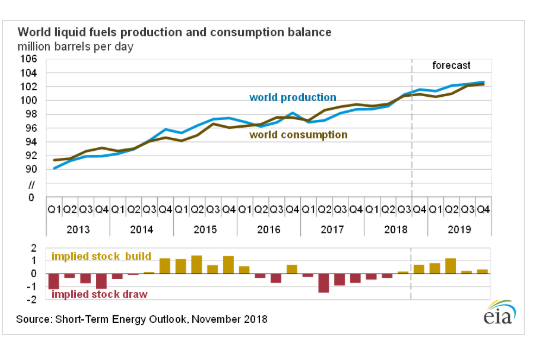The black gold is falling along with most investment classes, with things turning sore in the final quarter of the year. At the time of writing Tuesday, the WTI grade crude oil was trading at $56.14, down 6.32 percent from the previous session.
Rally Interrupted
The most recent downtrend began Oct 29. From Oct. 26 — the session before the sell-off began — through Monday, the commodity has shed a cumulative 11 percent.
In the same period, the S&P 500 Index has added 2.5 percent. Oil, which closed at $60.42 in 2017, is now lower for the year. This is despite the commodity remaining in an uptrend for much of 2018.
Ahead of the late-year sell-off, oil ran up to a closing high of $76.41 Oct. 3, a gain of about 27 percent for the year. The commodity is now in bear market territory, having lost more than 20 percent off its recent high.
A Muted Demand Forecast
Oil's fortunes are tied to economic development.
After stimulative monetary and fiscal policies fueled global growth after the 2007 U.S. financial crisis, the pace of growth is slowing, dragged by monetary policy normalization in the U.S., trade tensions and the challenges faced by emerging economies.
The outlook for oil demand doesn't look bright. In its latest monthly oil market report, OPEC lowered its year-over-year oil demand growth forecast for 2018 by 40,000 b/day to 1.50 mb/day, citing weaker-than-expected demand from the Middle East and China during Q3.
Total global demand in 2018 is estimated at 98.7 mb/day by OPEC. The oil cartel also lowered its 2019 oil demand growth forecast by 70,000 b/day to 1.29 mb/day; it has been lowering its estimates for every month since July.
The Greenback's Strength
Oil is denominated in the dollar and shares an inverse relationship with the currency.
A firmer dollar would mean one can buy more oil for the same amount of dollars than what could have been purchased in the past. Year-to-date, the U.S. Dollex Index, an index tracking performance of the U.S. dollar vis-a-vis a basket of currencies, is up about 5.5 percent.
Surplus Production
Globally, the supply side looks cheery. U.S. crude oil stockpiles are on the rise, with expectations of additional Permian supply coming online once new pipelines become operational.
The U.S. has granted waivers that would reduce the impact of sanctions on Iranian oil exports. The Energy Information Administration estimates global oil production of an average of 10.7 mb/day in 2018, which is expected to increase to 11.8 mb/day in 2019. This compares to 9.4 mb/day in 2017.  Source: EIA
Source: EIA
The Trump Factor
Even as the demand-supply imbalance hurts prices, President Donald Trump fired another salvo in a Monday tweet.
Hopefully, Saudi Arabia and OPEC will not be cutting oil production. Oil prices should be much lower based on supply!
— Donald J. Trump (@realDonaldTrump) November 12, 2018
OPEC countries have been vocal about steadying prices by announcing a production cut to the tune of 1 mb/day as early as December.
As the year enters its last leg, the short-term outlook for oil doesn't evince much enthusiasm, barring some radical action from OPEC to stem the slide.
At last check, the United States Oil Fund LP USO was slipping 5.37 percent to $11.81.
Related Link: Ahead Of Earnings, Traders Nibble At This Energy ETF How to Invest In Oil
Edge Rankings
Price Trend
© 2025 Benzinga.com. Benzinga does not provide investment advice. All rights reserved.
Trade confidently with insights and alerts from analyst ratings, free reports and breaking news that affects the stocks you care about.